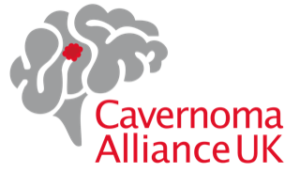We are Cavernoma Alliance UK
Founded in 2005, our aim is to provide support and information for all those affected by cavernoma including friends, family, carers and professionals.
With over 3500 members in the UK and worldwide, the charity aims to raise awareness of this relatively unknown condition throughout the general public as well as the medical community.
What is a cavernoma?
A cavernoma is made up of abnormal blood vessels and can be found in the brain and/or spinal cord and looks like a raspberry.
1 person in 625, in the UK, has a brain cavernoma without symptoms (asymptomatic). This equates to roughly 108,000 people – enough to more than fill Wembley Stadium. A spinal cavernoma is rarer than a brain cavernoma.
In this video, hear clinicians and members talking about their experiences of cavernoma.
Our services
Telephone Support
Our telephone support line is open 10am - 4pm, Monday to Friday
Email Support
You can reach us via email at any time, and we aim to respond as quickly as possible
Events & Annual Forum
We organise multiple events around the country
CaverBuddies
On going peer support when you need it most
Professional Lectures
Presentation and research events around the country
Meet Ups
Join us, and members from your local area for a coffee & chat
Therapy
Therapy for adults, children and carers to work though concerns
Webinars
Online meetings, presentations & chats providing information & advice
Carers Support
Support, chat and advice for carers of those with cavernoma
What our members say...
A world without CAUK doesn’t bear thinking about!
Get in touch with us
Annual Conference 2024 – registration is now live
Registration is now open for our 2024 Annual Forum taking place Saturday the 22nd of June from 10:00 to 16:00 via zoom. To secure your
Snowdon Climb for Cavernoma Awareness Month, 1st of June
On the 1st of June 2024, over 35 people will be climbing Snowdon to raise awareness and funds for Cavernoma Awareness Month in June. We
Results of the ‘Cavernomas: A Randomised Effectiveness (CARE) Study’
We’re really pleased to share that the results of ‘Cavernomas: A Randomised Effectiveness (CARE) Study’ have now been published in The Lancet Neurology. This pilot
“I knew my body better than anyone else. I learned to keep asking questions and always get a 2nd opinion.” Jac’s Cavernoma Story
My name is Jac Sinnott and I’m 39 years old. My cavernoma was located near my thalamus. I was diagnosed in July 2021 after hospitalisation following a bleed. I presented myself to the hospital with persistent symptoms which a couple of different GP practices said were migraines. Initially, my local hospital didn’t know what was causing my symptoms and it took a long time to get answers, especially as we were still in lockdown due to the pandemic.
My most recent symptoms appeared in late June 2021 and they presented as pins and needles down my left side as well as weakness and numbness on that side. I also had visual disturbances. Each episode would last for 30 minutes to an hour.
The Gut – Cavernoma Connection Emulsifiers and More with Dr. Shelley Stevens
Join Dr Shelley Stevens to discuss the gut-cavernoma connection, the impact of emulsifiers & more!
Dr Stevens is a toxicologist, and, being a mother of a child with brainstem cavernoma, Dr. Stevens has a special interest in the gut-cavernoma connection.
Steve Cairns – Recovering Movement Following Stroke & Brain Surgery, a New Perspective
Join host Steve Cairns as he talks about the changing face of Neuro Rehab and his case study with a Multiple Cavernoma patient.
CARE TRIAL: LATEST NEWS!
Care Study site teams across the country have successfully recruited 57 participants for the first ever pilot #clinicaltrial for #cavernoma. There are now only 3 participants left to recruit before the end of April.
CARE PREP: New cutting edge research trial for cavernoma
We are delighted to announce that a consortium, led by CAUK medical advisor Professor Rustam Al-Shahi Salman and comprising of a number of leading clinicians and patient advocacy organisation leaders – including David White of CAUK – has been awarded a grant to initiate the planning of an international ‘platform trial’ to test multiple potential cavernoma medications at a time.
CARE Study: Newsflash
We are delighted to report that the team at Kings College Hospital London has recently recruited its first two participants for the trial, with one patient randomised for ‘active treatment’ and the other randomised for ‘conservative management’. In equally exciting news, the team at Royal Hallamshire Hospital in Sheffield have recruited their sixth participant!
